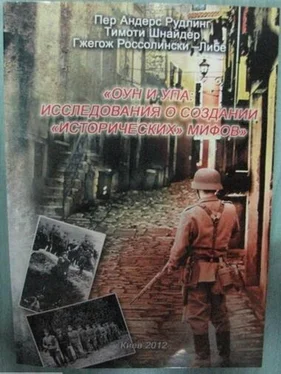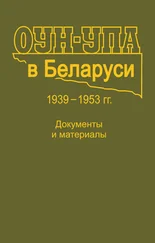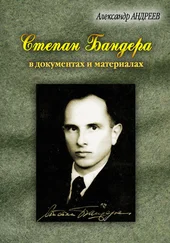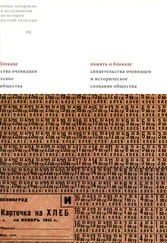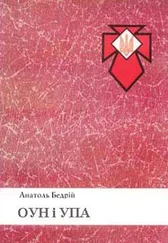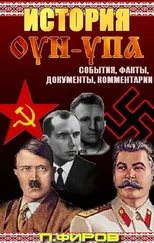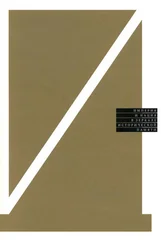For the activities of the Ukrainian militia during the pogrom, see Yones, Die Strasse nach Lemberg, 18–19; AZIH, 301-1809, Jaroslaw Korczynski (Zeznania ocalalych Zydow), 1; AZIH, 301/4654, Henryk Szyper, 6; AZIH, 301/1864, Salomon Goldman, 1; AZIH 229/22, Maurycy Allerhand (Teka Lwowska), 1; and AZIH: 229-54, Teka Lwowska, 1. For general accounts of the Ukrainian police forces during World War II in Ukraine, see Dieter Pohl, "Ukrainische Hilfskrafte beim Mord an den Juden," in Die Tater der Shoah: Fanatische Nationalsozialisten oder ganz normale Deutsche? ed. Gerhard Paul (Gottingen: Wallenstein, 2002), 202-34; and Gabriel N. Finder and Alexander V. Prusin, "Collaboration in Eastern Galicia: The Ukrainian Police and the Holocaust," East European Jewish Affairs 34, 2 (2004): 95-118. For information on German assistance in anti-Jewish measures, see Patryliak, Viis "kova diial "nist" OUN (B) u 1940–1942 rokakh, 232.
TsDAVOV f. 3833, op. 2, spr. 1, ll. 60, 62.
On the antisemitism of the OUN-B leader Iaroslav Stets'ko, see Karel C. Berkhoff and Marco Carynnyk, "The Organization of Ukrainian Nationalists and Its Attitude toward Germans and Jews: Iaroslav Stets'ko's 1941 Zhyttiepys," Harvard Ukrainian Studies 23, ¾ (1999): 149-84. For the activities of the Ukrainian militia, see Pohl, Nationalsozialistische Judenverfolgung in Ostgalizien, 46.
TsDAVOV f. 3833, op. 1, spr. 12, l. 10 (Telegram of Iaroslav Stets'ko to Stepan Bandera, no. 13, 25.6.1941).
U.S. Holocaust Memorial Museum, Record Group (USHMM RG) 31.018M, reel 20; Upravlinnia sluzhby bezpeky Ukrainy v Rivens'kii oblasti (USB v Rivens'kii oblasti), no. 19090, t. 3, ll. 3, 3v., 100, 101. On the militia, see also Pohl, Nationalsozialistische Judenverfolgung in Ostgalizien, 46.
According to Dmytro Honta, the printer of the posters, ten Jews were forced to help print the propaganda posters: see his "Drukarstvo Zakhidnoi Ukrainy pidchas okupatsii," Konkurs na spohady, Oseredok Ukrainian Cultural and Educational Centre Winnipeg, ll. 14–16. Some of the posters are in the collection of TsDAVOV. See TsDAVOV f. 3822, op. 1, spr. 63, ll. 112-14.
"Akt prohloshennia Ukrains'koi derzhavy," Samostiina Ukraina, 10 July 1941, 1.
"Sviatochna akademiia," Ukrains'ke slovo, 24 July 1941, 1.
BA Berlin-Lichterfelde: NS 26/1198, ll. 1–5, 10.
Ibid., ll. 9-12.
The OUN-B member Volodymyr Stakhiv sent to "Your Excellency" Adolf Hitler on 23 June 1941 an official letter in which he informed Hitler that the OUN believed that the Jewish-Bolshevik impact on Europe would soon be checked and that the "recreation of an independent national Ukrainian state in the terms of the Brest-Litovsk peace treaty will stabilize the national [volkisch] New Order." In the name of the OUN leader Stepan Bandera, Stakhiv also sent out a memorandum about the resolution of the Ukrainian question. See Bundesarchiv Koblenz R 43 II (Reichskanzlei)/1500, l. 61, memorandum on ll. 63–77. The OUN-B member Rikhard (Riko) Iaryi also sent a telegram from Vienna to Berlin; he assured Hitler of the OUN-B's loyalty, its readiness to struggle together with the "glorious German Wehrmacht" against "Muscovite Bolshevism," and its willingness to mobilize more Ukrainians living in Germany who could fight for the "liberation of Ukraine" and "finish with the chaos in Eastern Europe." See TsDAVOV f. 3833, op. 1, spr. 22, l. 10.
BA Berlin-Lichterfelde: NS 26/1198, ll. 12–14.
Bruder, Den ukrainischen Staat erkampfen oder sterben, 135.
Ibid., 137. Franziska Bruder, "'Der Gerechtigkeit dienen': Die ukrainischen Nationalisten als Zeugen im Auschwitz-Prozess," in Im Labyrith der Schuld: Tater-Opfer-Anklager, ed. Irmtrud Wojak and Susanne Meinl (Frankfurt am Main: Campus, 2003), 138, 148.
Diukov, Vtorostepennyi vrag, 66.
Ievhen Stakhiv, Kriz' tiurmy, pidpillia i kordany (Kyiv: Rada, 1995), 99-100.
BA Berlin-Lichterfelde, R 58/217, Ereignismeldungen UdSSR, Berlin, 10 September 1941, no. 79, 1. 10; Berlin-Lichterfelde, R 58/216, Ereignismeldungen UdSSR, Berlin, 9 September 1941, no. 78, 1. 355.
TsDAVOV f. 3833, op. 1, spr. 29–35.
There are only four letters in the Politische Archiv des Auswartigen Amtes, R 105191 (Akten betreffend Ukraine: Lage der Volksdeutschen. Gebietsanspriiche Rumaniens. Ukr. Nationalbewegung, Denkschrift z. Entwicklung d. ukr. Gebiete). I cannot say how many letters were actually sent to Berlin.
For example, TsDAVOV f. 3833, op. 1, spr. 29, l. 4 (Letters from Iavlon'ka, Raznychi, and Tel'chi).
For example, ibid., spr. 31, ll. 29–30 (Letter from Steniatyn to Stepan Bandera, 19 July 1941) or spr. 30, ll. 8–9 (Letter from Barani Peretoki to Iaroslav Stets'ko).
Ibid., spr. 31, l. 1. The handwritten letter is titled Zaiava da Uriadu Iaroslava Stets'ka.
Ibid., spr. 29, ll. 2–3 (Resolution from the village of Elblanivka, 13 July 1941). Here and below, these citations are example texts.
Ibid., l. 13 (Letter from the village of Ksaverivka, 19 July 1941).
Ibid., spr. 31, l. 36 (Letter from Steniatyn to Adolf Hitler, 19 July 1941).
Ibid., spr. 29, l. 9 (Letter from the village Ksaverivka to Iaroslav Stets'ko, 18 July 1941).
Ibid., spr. 29.
Letters and telegrams from various places declaring loyalty to the OUN-B government and the new administration as well as several descriptions of celebrations of the proclamation of the Ukrainian state are in ibid., spr. 15.
"Zvit robochoi hrupy istorykiv pry Uriadovii komisii z vyvchennia diial'nosti OUN i UPA," www.ukraine-poland.com/u/publicystyka/publicystyka.php?id=3480 (accessed 24 February 2009); TsDAVOV f. 3833, op. 1, spr. 45, l. 2. See also "Zvit pro robotu v spravi orhanizatsii derzhavnoi administratsii na tereni Zakhidnykh oblastei Ukrainy," TsDAVOV f. 3833, op. 1, spr. 15, ll. 1–4.
TsDAVOV f. 3833, op. 1, spr. 34, l. 40 (Report from the meeting of Ukrainian citizens of Zolochiv district).
Ibid., spr. 45, l. 2 (Ivan Klymiv's report to the leadership of the OUN).
Ibid., spr. 29, l. 1. The text of the letter from the village of Rudnyky was used with small modifications in letters from other places like Omel'no, Kulikovychi, Iavlon'ka, Raznyi, Tel'chi, etc. See ibid., ll. 1, 4–5.
Ibid., ll. 13–14. A list of 80 signatures is affixed to the letter. The same letter was also ad dressed to Iaroslav Stets'ko and signed by 75 people (ibid., ll. 9-12).
Ibid., spr. 31, ll. 29–30, 36–37, 31–32, respectively.
Ibid., l. 36. In another part of the same letter the enemies are called "bestial Asiatics" (zizvirili aziaty).
Ibid.
Regarding plenipotentiaries in 19th-century Galicia and the Habsburg empire, see John Paul Himka, Galician Villagers and the Ukrainian National Movement in the Nineteenth Century (Basingstoke, UK: Macmillan, 1998), 20–21.
Читать дальше
